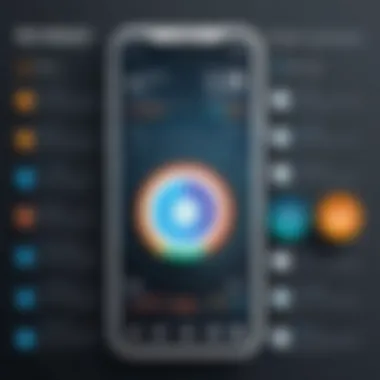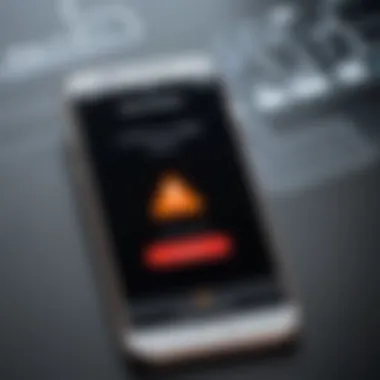Exploring Safety Applications for Mobile Devices


Intro
The emergence of smartphones has fundamentally altered how individuals interact with each other and their environment. Alongside this evolution is the growing need for personal safety, prompting the development of various safety applications. These apps are designed to provide users with security features that range from emergency alerts to location tracking. Today’s society demands a heightened focus on personal safety, especially in an era marked by increased urbanization and technological dependence. As a result, understanding the different safety applications available can greatly enhance one’s ability to stay secure in various situations.
This article delves into safety applications for mobile devices, examining their functionalities, strengths, and potential drawbacks. IT professionals and tech enthusiasts will benefit from a robust analysis of performance metrics and user experience, ensuring a comprehensive understanding of these tools.
Performance Metrics
To effectively evaluate safety applications, it is essential to consider their performance metrics. These metrics not only gauge functionality but also indicate how well these apps operate under different conditions.
Benchmarking Results
Performance benchmarking provides a comparative overview of safety applications. By quantifying various aspects such as response time and resource usage, these benchmarks highlight which applications perform reliably. Studies show that apps with high reliability typically feature well-optimized code, thus reducing battery consumption and minimizing lag during use.
Speed and Responsiveness
User experience is closely tied to an app's speed and responsiveness. Safety applications should allow users to take immediate actions in critical situations. Delays could lead to dire consequences, making speed a crucial consideration. Most reputable apps are designed to respond swiftly to user commands, ensuring that panic buttons or alert features activate almost instantaneously.
However, some applications may differ in their performance based on the device and network conditions. Users should pay attention to reviews and testing results that highlight any issues related to slow load times or unresponsive interfaces.
Usability and User Experience
An application's usability is as significant as its functionality. Evaluating safety apps should involve examining both installation processes and the overall experience of using the app.
Ease of Installation and Setup
An intuitive installation process can encourage more users to utilize a safety application. Complicated setups can deter potential users who may find the process frustrating. Many apps prioritize simple installation, allowing users to get assistance quickly. Those who wish to have enhanced security should look for applications that offer a straightforward onboarding process, ensuring that users can set up necessary features without technical difficulties.
Interface Design and Navigation
The interface design significantly impacts user experience. A well-designed interface enhances usability, while an overly cluttered or complicated layout can confuse users. Safety apps ought to feature a clean interface, allowing users to navigate quickly in high-stress situations.
For instance, easy access to emergency features must be evident. Apps that integrate large buttons with clear labeling improve accessibility. Users searching for effective safety solutions should prioritize applications that provide simple yet functional interfaces.
"The ability to navigate effectively during a crisis makes the difference between complacency and action."
Prelude to Safety Apps
The increasing reliance on mobile devices has given rise to a range of safety applications designed to augment personal security. This section addresses the foundational aspects of these apps, explaining their significance in today's fast-paced environment. Safety apps are not merely a convenience; they are essential tools that can help users navigate emergencies, find assistance, or simply enhance their sense of security.
With smartphone usage soaring globally, understanding the necessity of safety applications is crucial. Mobile safety solutions come equipped with various functionalities such as emergency alerts, location tracking, and panic buttons, responding directly to the user’s safety needs. By prioritizing user-centric features and real-time responsiveness, safety apps strive to reduce response times during critical situations.
From urban dwellers to frequent travelers, the spectrum of users is vast. Each group faces distinct challenges. For instance, city residents confront regular threats such as theft, while those in remote areas may need different forms of assistance. The app landscape must cater to these varying needs, making it imperative for users to comprehend the available options and choose wisely.
Understanding Mobile Safety Needs
Mobile safety needs arise from several factors, including personal lifestyle, environment, and the specific risks individuals face. As urban areas grow in complexity and rural spaces often lack immediate help, identifying potential threats enhances awareness. Users must assess their situations and determine what safety features matter most to them. For example, one might prioritize rapid location sharing in high-risk locations, while another may seek an app with direct connections to local emergency services.
Awareness also plays a significant role in app adoption. Many users remain oblivious to the range of safety features available or may underestimate potential risks. Education around mobile safety programs can empower users and contribute to better choices.
The Evolution of Safety Applications
The landscape of safety applications has transformed dramatically since the advent of mobile technology. Initially, these apps focused predominantly on basic communication, such as dialling emergency contacts. Today, they embody sophisticated capabilities powered by advances in software development and hardware improvements.
Over time, developers have introduced features such as geolocation tracking, which provides a precise understanding of the user's location during emergencies. This integration enhances response mechanisms, allowing for quicker and more efficient assistance.
The evolution continues, as emerging technologies like artificial intelligence play a role in predicting safety risks. These advancements facilitate a proactive rather than reactive approach to safety. Applications are now designed not only to respond to issues but to prevent them from occurring in the first place.
"The transition from basic utility functions to advanced predictive safety measures signifies a major shift in the mobile app landscape, enhancing user protection significantly."


In the following sections, we will delve deeper into specific types of safety applications and the essential features they provide.
Types of Safety Apps
The landscape of safety applications is vast and continually evolving. Understanding the types of safety apps is crucial for anyone looking to enhance their personal security. Each type serves a distinct purpose, catering to various safety needs, and understanding these distinctions can help users make informed choices. Furthermore, various elements like ease of use, accessibility, and feature set impact their effectiveness.
Emergency Assistance Apps
Emergency assistance apps stand at the forefront in terms of personal safety. These applications are designed to provide immediate help in emergency situations. They allow users to contact emergency services, notify friends or family, and sometimes even provide real-time location sharing. The importance of these apps cannot be overstated, especially in critical situations where every second counts.
Key features of emergency assistance apps include:
- One-touch emergency calling.
- Geo-tracking capabilities.
- Alerts to designated contacts.
"In emergency situations, having a direct line of communication with local authorities can drastically change outcomes."
Selecting an appropriate app requires reviewing factors such as the app's responsiveness, user interface, and integration with local services. Such assessments help ensure that help can be summoned quickly, effectively enhancing personal security.
Location Tracking Apps
Location tracking apps offer substantial benefits, particularly for those concerned about their personal safety while on the go. These programs enable users to share their location with trusted contacts, providing peace of mind in unfamiliar environments. Many apps also come with features like real-time alerts when a user arrives at or leaves a designated location.
Considerations for location tracking apps include:
- Accuracy of geolocation.
- User control over sharing settings.
- Battery consumption during tracking.
In today’s mobile-centric world, location accuracy remains a critical factor for these apps. If a user cannot accurately be located in case of an emergency, the app fails its primary purpose. Thus, a thorough understanding of how each app performs in different settings is vital for users prioritizing safety.
Personal Panic Alarm Apps
Personal panic alarm apps serve a specific need for users who want a quick means of signaling distress without having to engage in a full emergency communication. These apps typically allow users to trigger a loud alarm sound, send alerts, or even engage the phone's camera to record a situation.
Important features to look for include:
- Sound options and volume flexibility.
- Ability to directly notify authorities or contacts.
- User-friendly interface for quick access.
These apps empower users by providing them tools to respond proactively to threatening situations. The simplicity and immediate utility of a panic alarm app make it a valuable addition to anyone's safety toolkit.
By evaluating the different types of safety apps, users can identify which one aligns best with their individual safety needs. Educating oneself about the functionalities and considerations surrounding these applications can better prepare users to respond to potential threats.
Key Features of Safety Apps
Safety applications have emerged as indispensable tools for enhancing personal security in an increasingly complex digital landscape. To effectively serve their purpose, these apps must integrate key features that cater to user needs, which can vary widely from one individual to another. In this section, we will explore the crucial elements that determine the effectiveness of safety apps, focusing on usability, real-time alerts, emergency service integration, and data privacy and security features. This understanding assists users in making informed decisions regarding the selection of the most suitable app for their needs.
User Interface and Usability
An app's user interface is the first point of contact for users. It is critical for safety apps to possess an intuitive design that simplifies navigation. Usability directly impacts the overall user experience, particularly in emergency situations. Complex interfaces can lead to confusion, potentially hindering users from accessing vital features quickly.
Here are some key considerations in user interface design:
- Clarity: Clear icons and straightforward language contribute to ease of use.
- Accessibility: Apps should be designed for all users, including those with disabilities.
- Response Time: Fast loading times and seamless functionality support users in urgent scenarios.
"An effective user interface can be the deciding factor in whether an app is utilized in times of crisis."
Real-Time Alerts and Notifications
Real-time alerts are among the most significant features of safety applications. They enable users to receive immediate information regarding potential threats or emergencies. Timely updates can be life-saving in situations requiring urgent action. Safety apps often employ push notifications to deliver critical updates directly to users' devices.
Key aspects to consider regarding this feature include:


- Customization: Users should have options to set specific alerts based on their preferences.
- Location-Based Alerts: Notifications can be tailored based on the user's current geographical context. This adds more relevance to the alerts received.
- Integration with Other Apps: The ability to sync alerts with calendars or other organizational tools enhances user preparedness.
Integration with Emergency Services
The importance of integrating safety apps with local emergency services cannot be overstated. This integration allows for swift communication with law enforcement, medical responders, or fire departments in critical situations. Features may include direct dialing of emergency contacts or the automatic transmission of a user's location.
Consider the benefits of this integration:
- Efficiency: Direct access to emergency services reduces response time.
- Geolocation Data: Sharing location data ensures that responders can find the user quickly, even if they are unable to communicate their whereabouts.
- Two-Way Communication: Some apps allow for real-time dialogue with emergency dispatchers, improving situational awareness and response effectiveness.
Data Privacy and Security features
Data privacy is a paramount concern for users of safety apps, especially given the sensitive information these apps might handle. It is essential to choose applications that prioritize user data protection. This includes implementing robust encryption methods and adhering to regulations regarding data storage and usage.
Key elements in this area should include:
- User Consent: Apps should obtain explicit permission before collecting personal data.
- Transparency: Clear privacy policies should explain how user data is used and shared.
- Secure Data Handling: This involves protective measures against unauthorized access, ensuring that user information remains confidential.
Comparative Analysis of Safety Apps
The comparative analysis of safety apps is crucial in understanding the current landscape of mobile security solutions. By evaluating different applications side by side, users can identify which features are most relevant to their needs. This analysis assists both IT professionals and everyday users in making informed decisions. Additionally, comparing apps reveals trends in the market as well as consumer preferences, leading to continuous improvement in app offerings.
In a digital age where personal safety is often vulnerable, having robust mobile applications can significantly enhance protection. Nevertheless, with a plethora of choices available, distinguishing between quality applications and those that fall short can be challenging. A thorough comparison makes it easier to navigate this complex market.
Market Leaders Overview
An overview of market leaders in safety apps highlights the most reputable options available today. Apps like Life360, Noonlight, and bSafe have emerged as frontrunners, each offering unique functionality tailored towards enhancing user safety. Life360 focuses on family location tracking and alerts, allowing users to stay connected with loved ones. Noonlight provides emergency response features that can be activated discreetly, ensuring rapid assistance when needed. bSafe blends personal panic alarms with real-time location sharing, catering especially to individuals who prioritize immediate help.
A comparative analysis of these apps reveals several distinct aspects:
- Features: Explore the specific safety features offered by each app. For example, Life360 includes driving reports, whereas Noonlight has a more robust emergency call system.
- User Experience: This includes the intuitiveness of the interface and ease of navigation. Users often prefer apps that require less effort to operate in critical situations.
- Pricing Models: Understanding what you get for free versus premium features is essential. Some apps offer basic security measures for free, while advanced capabilities may require subscriptions.
In evaluating these elements, users can ascertain which app best aligns with their personal safety requirements.
User Reviews and Feedback
User reviews serve as invaluable resources for assessing the effectiveness of safety applications. Accounts from real users can shed light on practical usability, reliability during emergencies, and the overall satisfaction with the app's features. For example, feedback on Life360 often emphasizes the seamless integration of location tracking, making it a top choice among families. Conversely, Noonlight has received mixed reviews regarding accessibility and response times during emergency situations.
When considering user reviews, it is important to analyze both positive and constructive criticisms. Key factors to look out for include:
- Performance Under Stress: How well does the app function during high-pressure situations?
- Customer Support: Are users satisfied with the support provided when they encounter issues?
- Updates and Improvements: Regular updates can indicate a developer’s commitment to addressing user feedback and enhancing app features.
User feedback is not just a reflection of satisfaction; it is a lens through which potential users can gauge the app's reliability and practicality in real-world scenarios.
Considerations for Selecting a Safety App
Selecting an appropriate safety app is crucial for individuals who seek to enhance their personal security through mobile technology. Different users have varying needs, and the right app should align with specific safety requirements and personal comfort levels. Moreover, the market is saturated with options, making it essential to navigate wisely through features, functionalities, and reputation.
Assessing Personal Safety Requirements
When evaluating which safety app to choose, users must first assess their own safety needs. This involves reflecting on the situations they most often find themselves in. Are they mostly in urban areas where crime rates are higher, or do they often engage in outdoor activities? Some users, for example, may require robust location tracking for outdoor adventures, while others, particularly those living in high-risk environments, may prioritize emergency assistance features.
Furthermore, the user should consider their personal lifestyle and preferences in technology. Some apps may offer an overwhelming number of features that may be unnecessary for their specific context. It is advisable to prioritize simple yet effective functionalities that address the core concerns.
Evaluating App Reputations
The reputation of a safety app is often a good indicator of its reliability. It is important to look at user reviews and expert analysis to determine how well an app performs in real-life situations. Potential users should explore multiple platforms like Reddit or Facebook to gather firsthand experiences from existing users.
Additionally, the credibility of the developers plays a significant role in evaluation. Apps from well-established companies often have a track record of continuous updates, which can enhance safety features and provide users with ongoing support. An app’s engagement with user feedback is also a beneficial metric to consider; this can often reflect the commitment of its developers to improve their service.


Cost vs. Features Analysis
Cost is often a determining factor in the selection process. While some safety apps are available for free, many others operate on a subscription-based model. Users should analyze what features and functionalities come with each option at its price point. Sometimes, a higher-priced app may offer unique capabilities that could justify its cost, such as advanced AI-driven alerts or comprehensive emergency service integration.
Conversely, several free options may meet basic safety needs without breaking the bank. Users should not only focus on the monetary aspects but weigh them against the value offered by the app. Understanding exactly what features are required for one’s safety can help users make informed decisions without overspending on unnecessary services.
"The effectiveness of a safety app is only as good as the thought you put into selecting it. Crucial considerations can lead to safer choices."
The Role of Technology in Safety Apps
The integration of technology into safety applications is a fundamental aspect that enhances their functionality and usability. As mobile devices become increasingly ubiquitous, the role of technology in safety apps is paramount in ensuring that these tools not only meet the evolving demands of users but also provide a higher level of security. This section delves into how various technological advancements impact the safety app landscape, highlighting benefits, functionalities, and considerations for users.
Artificial Intelligence in Emergency Response
Artificial intelligence (AI) serves as a cornerstone for many safety applications today. Its ability to analyze vast amounts of data in real time enhances emergency response capabilities significantly. For instance, AI algorithms can be programmed to assess user behavior patterns. In critical situations, such as car accidents or sudden falls, these systems can detect anomalies and initiate automatic alerts to emergency services, ensuring a prompt response.
Moreover, AI can improve user experience through personalized recommendations. Tools powered by machine learning can understand the unique needs of users and adapt accordingly. This adaptability extends to various scenarios, such as suggesting emergency contacts or providing directions to the nearest help center when a user feels threatened. Therefore, the synergy between AI and emergency response epitomizes the potential of technology in creating effective safety applications.
Geolocation Technologies and Their Applications
Geolocation technology is another pivotal component of safety applications. The precise location tracking allows users to share their whereabouts with trusted contacts and emergency services, providing an added layer of security. Many apps utilize GPS technology to deliver real-time location data. This functionality is crucial during emergencies, as it helps responders locate individuals quickly.
In addition to immediate security concerns, geolocation features serve several other purposes. They can enhance the overall functionality of personal safety tools, including:
- Journey tracking: Users can share their route with friends or family, allowing them to monitor travel progress.
- Geofencing: Safety apps can create virtual perimeters to alert users when they enter or exit designated areas, ultimately enhancing personal safety.
- Safety alerts: When a user enters a high-risk area, the app can send notifications, enabling users to take caution or alter their route.
In summary, the role of technology, specifically through artificial intelligence and geolocation systems, is crucial in developing effective safety applications. These technological advancements not only enhance the reliability of safety tools but also empower users to take proactive steps in protecting themselves. As these technologies continue to evolve, the synergy between them will be essential in shaping the future of mobile safety.
Future Trends in Mobile Safety Apps
The exploration of future trends in mobile safety apps is paramount in understanding how technology continues to shape personal security measures. As society evolves, so do the tools we use for our protection. The importance of anticipating these trends cannot be overstated. With increasing threats to personal security, the demand for more effective, innovative, and user-friendly safety applications is surging.
Emerging Technologies Impact
The impact of emerging technologies on mobile safety apps is significant. Technologies like Artificial Intelligence and Machine Learning enhance the capabilities of these applications by improving situation awareness and response times. For example, AI can analyze user behavior patterns and predict potentially dangerous situations, allowing preemptive alerts.
Moreover, blockchain technology introduces greater transparency and security in data handling. With growing concerns about data privacy, utilizing blockchain can ensure that personal information remains secure and immutable.
Some specific advancements to watch include:
- Wearable technology integration: Devices such as smartwatches are increasingly being linked to safety apps, providing immediate access to assistance.
- Augmented Reality (AR): It can provide real-time information and risks in a user's immediate vicinity.
- Drones: These may soon play a role in monitoring areas for personal safety alerts, especially in public events.
User-Centric Innovations
Focusing on user-centric innovations is crucial for the development and adoption of mobile safety apps. As users' needs and behaviours evolve, technology must keep pace. Safety apps should be intuitive and accessible, enhancing user engagement without overwhelming them.
Key factors include:
- Customization: Users appreciate apps that can be tailored to their specific needs, such as changing notification settings or integrating personal contacts for emergency alerts.
- Enhanced user interfaces: A clean, straightforward design helps in quickly navigating the app in stressful situations.
- Feedback loops: Engaging users in feedback significantly improves the app's functionality and relevance.
"User feedback can guide the enhancement of safety app features, ensuring they meet evolving expectations and needs."
End
The conclusion of this article is critical. It ties together all insights and discussions presented in the previous sections. By synthesizing the information, we can clarify the relevance of safety applications in contemporary society.
Summarizing Insights
Safety applications for mobile devices play a vital role in enhancing personal security. The needs for such applications have evolved significantly. They now encompass a range of features, such as emergency assistance, location tracking, and panic alarm functionalities. High-quality apps demonstrate excellent user interfaces, facilitating easy navigation. Also, their integration with emergency services ensures timely responses. Importantly, the focus on data privacy and security features assures users their information remains safe. Each of these factors contributes to the overall effectiveness of safety apps. Users must understand the main features that differentiate the available options in the market.
Final Thoughts on Safety Apps
In evaluating safety applications, one should weigh the benefits and limitations carefully. The landscape of safety apps is constantly evolving, driven by user needs and technological advancements. Emerging technologies, such as artificial intelligence and geolocation, enhance the capabilities of these applications. However, potential users must also consider aspects like app reputation and cost versus features. Thus, it is essential to be informed while selecting the most suitable safety app tailored to individual needs. Ultimately, a well-chosen safety app can significantly contribute to personal security, providing peace of mind in an increasingly uncertain world.
"The right safety app can create a safety net, ensuring that help is just a tap away, transforming how we approach personal security."
By thoughtfully considering the information discussed, readers can make informed decisions about mobile safety applications, leading to enhanced personal safety.



